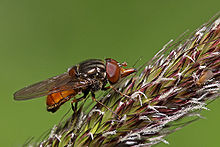Common snout hover fly
| Common snout hover fly | ||||||||||||
|---|---|---|---|---|---|---|---|---|---|---|---|---|

Common snout hover fly ( Rhingia campestris ) |
||||||||||||
| Systematics | ||||||||||||
|
||||||||||||
| Scientific name | ||||||||||||
| Rhingia campestris | ||||||||||||
| Meigen , 1822 |
The common snout hover fly or field-beaked hover fly ( Rhingia campestris ) is a fly from the family of hover flies (Syrphidae).
features
The common snout hover fly reaches a body length of 8 to 11 millimeters and has a slightly stocky build. It has the elongated face characteristic of beaked hover flies. The trunk below the snout is rust-red, the tip slightly darker. In contrast to the similar Rhingia rostrata , the trunk is slightly longer and straight forward. The hairless compound eyes are wide in the female, but only separated by a fine seam in the male. The antennae are hairy short. The entire thorax is also briefly hairy, the brown-black mesonotum bears four gray longitudinal lines. The label is reddish and slightly transparent. The abdomen is yellow-red in color, the back of each tergite is brown, as is a longitudinal stripe on the back. In the similar species, the terga are not bordered dark. The wings are colored slightly reddish brown. The legs are rust-red, the tarsi and the base of the thighs ( femora ) are black. The splints ( tibia ) have a dark ring in the middle.
Occurrence
The animals occur in Europe and Asia as far as Japan . They are common and widespread in Central Europe . They live in fields, meadows and on forest paths.
Way of life
The Imagines can suck with its very long proboscis to much more nectar than is possible other flies. For example, they suckle Günsel , oregano , cranesbills , thistles and spring herbs , but prefer blue and purple flowers. The animals fly in two to three generations from April to September. The females lay their eggs on blades of grass next to cow dung. The larvae live in the cow dung and also feed on it.
swell
- Gerald Bothe: Hoverflies. German Youth Association for Nature Observation , Hamburg 1996. [1]
- Joachim & Hiroko Haupt: Flies and mosquitoes: observation, way of life. Naturbuch-Verlag, Augsburg 1998, ISBN 3-89440-278-4 .
- Nature in NRW


